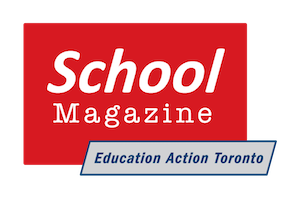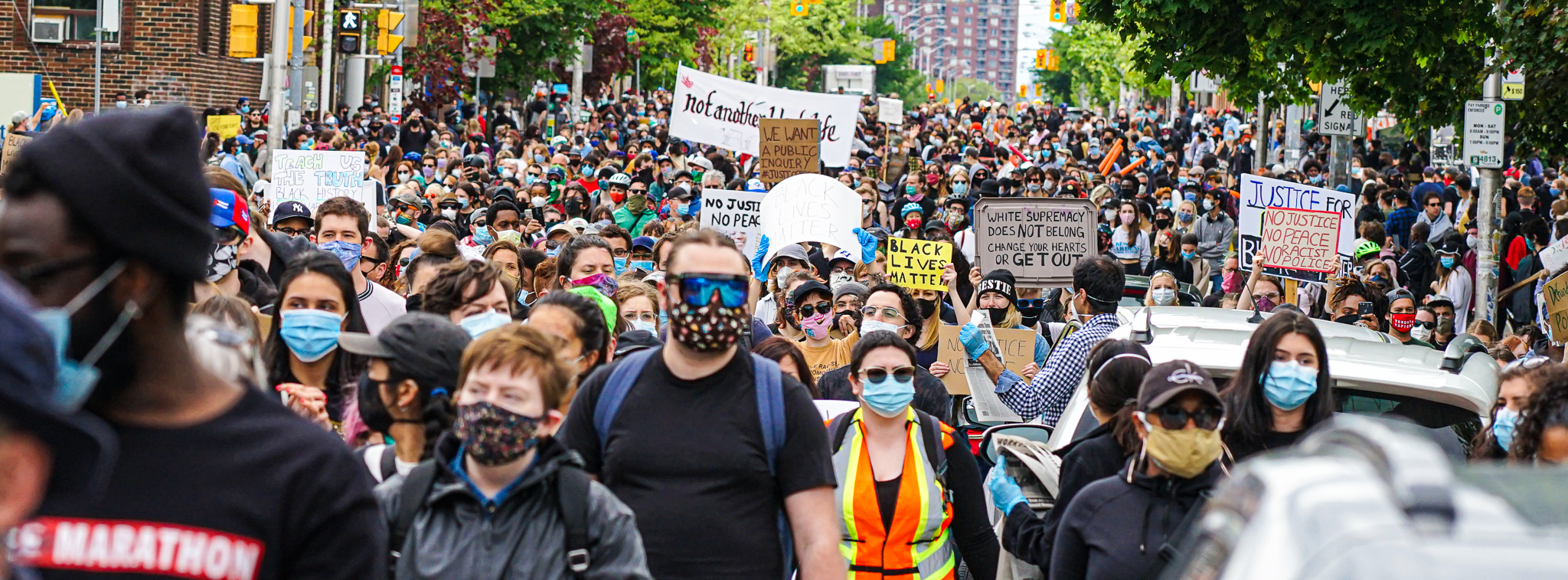Deconstructing anti-Black racism – a high school course
By: Tiffany Barrett, D. Tyler Robinson, Remy Basu and Kiersten Wynter
At the beginning of the 2020-21 school year, four TDSB teachers moved the ball forward for anti-Black racism education. Tiffany Barrett, D. Tyler Robinson, Remy Basu and Kiersten Wynter presented a course about the language and history of anti-Black racism, what it means to students trying to understand themselves within it and what change could look like. The course entitled “Deconstructing anti-Black Racism in the Canadian and North American Context” is a grade 12 university prep or foundation course that ought to be mandatory learning for students across the province. Below, the authors of the curriculum explain what it contains.
White as the default normal
To understand anti -Black racism, students need to grasp all its assumptions and pervasiveness. We have to help them look at white supremacy in all its forms. But we need to clarify for kids that talking about white supremacy is not only talking about overtly racist Ku Klux Klansmen, Proud Boys and the like. It’s also talking about how sociologists, historians and academics are asking us to speak about white supremacy. This is the notion that white is the default normal: white culture and white values. White people are what’s normal and everything outside of that is levelled in degrees away from normalcy.
As we help kids really understand that, we can dig deeper. We can look historically, at how that default normal has affected everything from slavery to the Black Lives Matter movement. We can also look at it in the present, how it appears in the media now and how pervasive and powerful is this idea of white supremacy.
Most important, we can teach all kids whether they’re white, Black Indigenous South Asian, whoever they are, they have a responsibility to understand the systems and structures of white supremacy and that these can be replaced by new systems when the public understands and moves to change.
For example, look at the renaming Vaughan Secondary School. The York Region board ended up naming the school after Somali-Canadian journalist Hodan Nalayeh, but not before a lot of debate about who ought to be listened to. The school was originally named after Benjamin Vaughan, who owned about 300 slaves. While there were different groups putting in their thoughts about whose name should be on the front of the school, the reality was that Vaughan was a slave owner. The harm created by Vaughan and his family was done to Black people. So, if we’re going to redress that harm, we should be asking the Black community what that new name should be. But battling a “white as the default normal” perspective, it took a lot strain to get this point across.

At the same time, something like renaming school offers its own challenge. There’s a danger in getting rid of evidence of racism, making it seem as though it never existed. For instance, as we were developing our curriculum, we did research for the course into the use of the “n—–” word. There were all these relics that had n—–” word all over them that used to appear in grocery stores, on packaging – all over the place. Instead of talking about these historical artifacts – how they’re racist and why they were there, we’ve just hidden them. So, students may not even know about them and not see the problem they present.
The Aunt Jemima brand just went through a similar process. The people at PepsiCo which owns the brand woke up and said “Oh!, for generations, we’ve been exploiting this racist caricature of Aunt Jemima as the ‘mammy’ who is working in the kitchen – she’s such a great cook. We’d better change ‘Aunt Jemima’ to the Pearl Milling Company.” That image was exploited for a long time in the interests of capitalism and profit. The racist caricature had to go, but the question remains: “What was the harm, who was harmed and how do we address the harm?”
You can rename a school or a company but you have to talk about the old name and why you had to remove it. It involves digging into that history, that language and the effect of white supremacy on people that makes this course extend beyond discussing superficial brand changes and famous people. Our curriculum asks students to think about anti-Black racism in a broad way. This isn’t just a Black History Month topic.
We’ve divided the course up into four units:
Unit One: Language
Unit One is where we introduce high the frequency terms that come up when we talk about anti-Black racism, oppression and marginalized groups. We have a word bank of all of those words like privilege, white supremacy, micro-aggressions, overt racism and such. Students need to understand the language that is used in discussions about racism to be able to converse. This alone gives them power; they can put words to vague feelings and uncertain exchanges they might have had or seen take place as racialized people are treated differently, miss out on opportunities are insulted through media images and so on.
We also want to make sure that students understand how to have respectful discussions because we know there are prickly topics, that are going to have to be approached with some understanding. So, we purposely introduce some articles, images ideas that would really provoke some students- trigger them in a way. For instance, any discussion of the killing of George Floyd is bound to trigger some kind reaction. This is something we can use to help kids acknowledge their feelings, but put them to use to understand the history and racist attitudes that brought about such horrific events.
It’s also important for students to learn how to have conversations about these hard topics with compassion and respect.
Unit Two: Critical race theory
In Unit Two we address the fact that the Black experience is very much left out of Eurocentric curriculum. To explain that, we go backwards and teach about critical race theory. We look at where racism first occurs, where we first start hearing the words Black and white. Why was this social construct created? How was it connected it to imperialism, capitalism and the enslavement of Black bodies.
We want our students to look backwards and realize that the construct of race and racism was necessary to dehumanize people in order to enslave them- in order to bring them to the new world and exploit their free labour. It’s important that students understand that systemic purpose- that it was also about empire building. At the heart of empire building – there was competition between nations in Europe about money, land and power.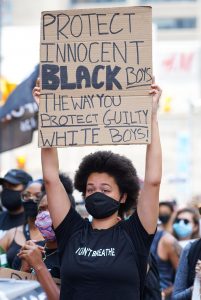
It’s important that students not begin their understanding of Blackness with the focus on slavery. That was how it was framed when we were all coming up through the system. When we talk about slavery, we talk about the enslavement of people by other people, so we can put the onus of responsibility where it belongs, but we put that in a larger context.
Beyond that we want students to go back before enslavement. They do a major project on Black civilization, its mathematic and scientific contributions, for instance. This way as kids explore their history, they can realize it is not only about the intersection of European white men and slavery.
There’s a lot to cover, as we pick and choose components of Black history in the Americas all the way up to the present. We include more Canadian content too so kids aren’t thinking, like we were taught, that Canada was the safe space for slaves to escape and once they got here, life was good. We want to tell them real stories of slavery in Canada along with its racist policies. We look at news clippings of slaves in Nova Scotia being posted in the local newspaper along with the price to buy them.
We also look at the United States and the legislation that valued Black people as 3/5 human beings, something that enabled injustice to continue unabated. It underscored the entrenched, self-serving belief that normalcy is white; that Black people can be exploited, segregated, neglected and killed.
This ideology didn’t stop at the U.S border. There is a common thread that runs through the experiences of Black people from the U.S. the West Indies as well the experience of Black people who have been in Canada for six or seven generations, that goes beyond the social construct of borders. So, we don’t only want to be tied to the Canadian experience because we see all of these experiences as a component of the African diaspora. They are all part of the same story.
As we do this work and as we teach kids about this history, they can see the systemic mechanisms that led to racism and come to realize or affirm that there’s nothing wrong with Blackness in itself. The experience and the social location of many Black folk now is the direct result of white supremacy and systemic racism: “I don’t have to feel bad about my Black skin, because I understand that the problem is actually with the systems and structures. We need to changes these systems and structures.”
Unit 3: What our students see and hear
This is where we discuss where the students themselves are positioned – what they see; what they hear. So, this unit focuses on the media and image of blackness – what it is and why it’s there. We look into racist caricatures like blackface and similar stereotypes. There’s a lot of analysis and discussion with students about images they observe in their music, their everyday lives and in the news and what these images mean to them? We’re trying to draw from them their interpretation of these images and why would bias occur in them
At this point, we start introducing the notions of action and what civic change looks like. We look at police brutality; we look at Black Lives Matter. We consider other movements for justice like Black excellence, Black business – 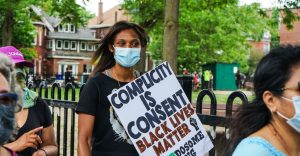 teaching about trailblazers before and today who are still doing the work of finding equality and equity. The discussions we have all pertain to and extend from the students’ immediate experiences: what they have seen and understood about Blackness now that these ideas have been framed in Unit 1 -the tools to talk about it; Unit 2 – the history up until present day. Now we ask: “What do you see in the broader picture of anti-Black racism? What makes you see that, what do you think and feel about that?”
teaching about trailblazers before and today who are still doing the work of finding equality and equity. The discussions we have all pertain to and extend from the students’ immediate experiences: what they have seen and understood about Blackness now that these ideas have been framed in Unit 1 -the tools to talk about it; Unit 2 – the history up until present day. Now we ask: “What do you see in the broader picture of anti-Black racism? What makes you see that, what do you think and feel about that?”
This unit is about how to understand Blackness. All of it is student-centred so we start with the students’ grasp of what Blackness means. Unit 3 is one in which students choose: What do we want to talk about? What areas of that do we want to focus on? How do we want to steer the conversation? Do we want to look at sports- at the systemic oppression there? Do we want to look at music? It’s all about what students see, what they want to dig deeper into and how they interpret it.
This notion of action is essential here. We’re not just going to passively take in and analyze and say this or that story is awful. We’re going to consider what can we do? What have we done?
Unit 4: Other marginalized groups
Now the students have the language, the knowledge, the terminology. They understand the history. They’ve had an opportunity to define and redefine Blackness as they see it through their personal lens.
With that in mind, we talk about connecting Black oppression to other forms of oppression: the idea that Black oppression maybe isn’t a singular event or experience. The students explore other marginalized groups and discuss issues like intersectionality, how different people share common experiences of racism and homophobia for instance. This is where all they’ve learned about the pervasive effects of white normalcy applies to other situations. Students also get an opportunity to analyze past and present activist movements and how they’ve facilitated progress. What were the positives and the negatives?
Now, we connect the oppression of Black people to other marginalized groups or how Black people are further oppressed within other marginalized groups. We’re talking here about Afro-Indigenous people, Black people who are part of the LGBTQ+ group. So now we’re making the connections beyond just Black oppression but what that looks like in other parts of society and in other marginalized groups.
If the students who take our course understand just that white is not the default normal, then we’ll have gone a long way to dispel the myths, the assumptions and hatred that cripple our society. If we can help them understand their responsibility for change and locate the tools to bring it about, then we’ve gone some distance towards helping them become engaged and self-confident.
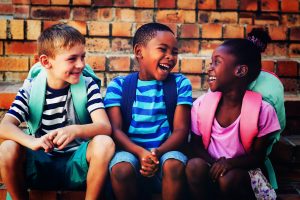
Click here read an interview with the authors of the curriculum where they talk about where it’s headed in development and people’s reaction to it.
